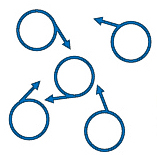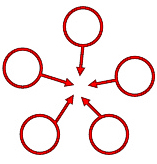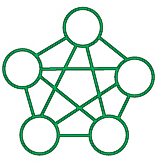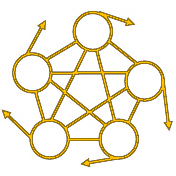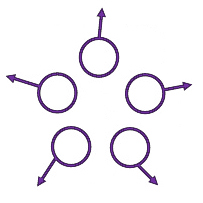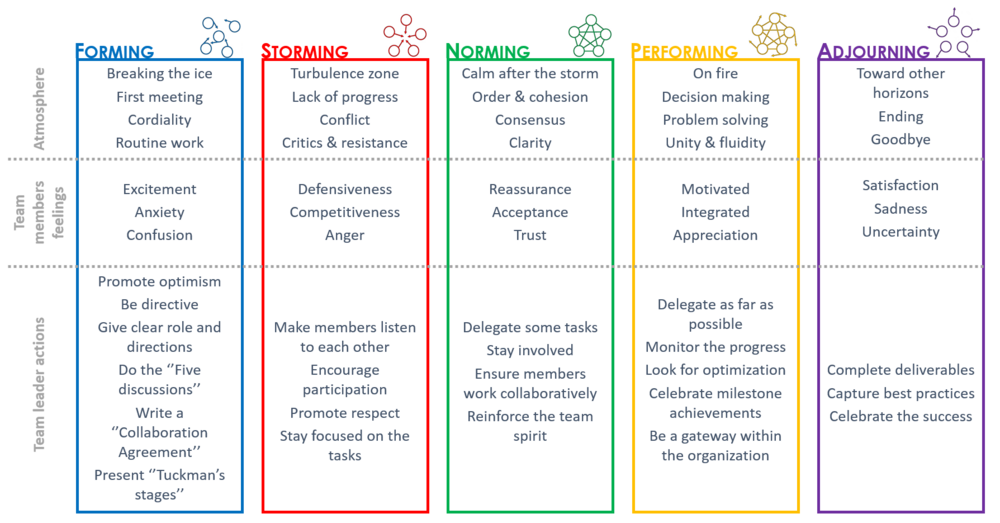How to successfully go through the Five Stages of Team Development
*Disclaimer: The articles are created by DTU students. As part of the course, students are introduced to knowledge related to IP rights, plagiarism and copyright infringement. Additionally, the articles are a product of critical engagement of students with the literature review, and their aim is to contribute to the Project Management holistic field of science. If you discover any potential copyright infringement on the site, please inform thereof by sending an email to ophavsret@dtu.dk.
Developed by Natacha Leduc
In today's companies, teamwork is considered as a strong asset to gain competitive advantage: it increases employee satisfaction and commitment to the company, and move the firm closer to a set of objectives [1]. But how can we, as individuals, reach a high level of efficiency and effectiveness in a team?
This wiki-article does not pretend to analyse all possible human behaviours and how to address them. It describes big steps of a project team that may be difficult to apprehend, also known as “Tuckman’s model”. Bruce Wayne Tuckman has published this model of a group development in 1965. Initially, it has only four stages; the fifth was introduced in 1977 by him and Mary Ann Jensen.
The model says that a team working on a project will inevitably go through five stages:
- Forming,
- Storming,
- Norming,
- Performing,
- Adjourning.
Each step is necessary to attain the highest level of performance and deliver high quality results (in the “Performing” stage). A common issue faced by the team is the desire to reach this step without going through the firsts. Usually, both team leader and team members underestimate the necessity to develop themselves into a cohesive group [2].
Modelizing a group development from a human point of view might be relevant for project management because it enables the reader to:
- Recognize, during his/her real projects, the atmosphere of one of the five stages,
- Perceive and understand his/her feelings, but also other members feelings,
- Take adequate actions regarding the situation if he/she is the leader.
This tool can be useful for both experienced and new practicioners, since they can step back in real life, recognize common situations and rely on "Tuckman's model" to deal with them.
Contents |
The “Five Stages” in practice
The basic schema that will be used for the “project team” is:
- one team leader,
- some team members that have never met before.
Knowing the “Five Stages” is a good basis for someone (a team member or a team leader) who has to work in a group. It answers the following questions:
- What is the general atmosphere and how do members behave?
- What do the team members feel?
- What should the leader do?
For each step, we will describe these three aspects [3] (1. external pictures, 2. internal feelings, 3. leader actions). The main goal, as already said, is to give the reader a general model on which he can rely on during a real project to step back and:
- Understand his/her current feelings, keep things in perspective (as a team member),
- Analyse the current situation, take action (as a team leader).
Forming
1. Breaking the ice
It is the first meeting: time to break the ice. The members introduce themselves to one another, they share information about their background, their experience and their interests. Everyone is cordial; conflict and disagreement are avoided because members want to be accepted by others and fit into the team.
Productivity at this stage is relatively low: roles are not clear and team members don’t know yet how to work together, so they focus on routine work to clarify the team’s mission. They discuss about the project goals, analyse the tasks that have to be done, establish a schedule and organise the future meetings. Members can also talk about their expectations around this project. Everyone is positive; the project seems to begin well.
Two factors will determinate the length of this stage:
- the ability of members to work in a team,
- the project clarity which depends on the team leader.
2. Apprehensive feelings
There are two main feelings that you might experience: excitement and anxiety.
Excitement because human has a natural tendency to want to be part of a community, so you are eager to build an amazing team. You can gather information and impression on your partners, even begin to form personal relationships.
Anxiety because this amazing team doesn’t exist (yet), you don’t want to be rejected by the others and you are confused about how the project will proceed. This feeling is less important for people who have already worked several times in a team.
3. Leader as a Guide
Promote optimism
So that team members are attracted and are willing to contribute to the project.
Be directive
In order to avoid confusion. Team members tend to be distracted, have a lot of question because there is so much doing at the same time.
Give clear goals and directions
Of the project. Anticipate confusing topics, listen carefully to members’ questions and answer them as clearly as possible. The less uncertainty, the quicker the team can move on.
Do the “Five discussions”
This topic is deeper explained in the nest session. The team members can pre-empt conflicts or at least anticipate them, regarding others way of working.
Write a “Collaboration Agreement [4]”
So that all team members have to be involved to answer questions around meetings, expectations and conflicts. It is essential to set ground rules and frame the project.
Present Tuckman’s model
The more members are aware of how the team will progress, the better ready they are to tackle issues.
Storming
1. Turbulence zone
The project has not really begun: team members are impatient about the lack of progress. As they confront ideas and perspectives, they realize that the tasks are more difficult than imagined.
They try to clarify and brainstorm: different opinions emerge on what to do and how to do. Members choose sides, fight for their ideas, express their views strongly. It can lead to disagreement, conflict and even disruption if it is not properly handled. The original team goal may be criticised and members may resist the tasks or blame the team concept.
Some teams will never move into a more mature stage because members are getting stuck in seeing members as competitors, which can lead to the team’s failure. It is a critical but also constructive stage when successfully passed.
2. Frustrated feelings
This stage is quite frustrating: feelings like defensiveness and competitiveness arise and are difficult for someone who doesn’t like conflict. You fight for consideration and acceptance; it is like a bid for power.
You can also feel angry and jealous while competing with the others, if it becomes more an argument than a discussion.
In this oppressive atmosphere, you may be concern about the team ability to achieve goals.
3. Leader as a Facilitator
Make members listen to each other
A member cuts someone off or several people talk at the same time: these are signs of poor communication and lack of active listening.
Encourage participation
If a member monopolizes the discussion: say it politely. On the contrary, if someone is quiet, give him/her the chance to explain his/her point of view. By facilitating contribution from all members, the team will progress quickly in this difficult stage.
Promote respect
If the discussion heats up, members can become aggressive and sometimes insulting. The team can be profoundly damaged and this can lead to low morale, low motivation and even breaking apart. This kind of situation has to be very quickly handled and eased.
If a member is particularly bellicose and don’t take warnings into account, a private meeting is necessary. This kind of behaviour will, if not handled, badly affect the team progression and atmosphere.
Stay focused on the tasks
If attention is drawn away from tasks, the team won’t be efficient. Be concentrate on the project scope facilitate the progress.
Norming
1. Calm after the storm
After the turbulent phase, there is an establishment of order and cohesion. Members collaborate and make consensus for the good of the project. They help each other, give assistance and input, and succeed in interacting efficiently. They are less focused on individuality but more on how to work together: before it was more a group but now we can really speak of a “team”.
Team rules are clarified, such as information sharing, communication, tools, processes, procedures, meetings, planning or values. Roles are now clearer and real strategy and purposes are defined: every member knows the tasks he must complete and work becomes productive.
The team switches back and forth between the “Storming” and “Norming” stages as long as problems appear. But issues will be addressed easier and easier as the team matures, develops a problem-solving process and a code of conduct.
2. Comfortable feelings
After the fight, your animosity toward others decrease and you feel reassured. Members differences, strengths and weaknesses are no more a problem; you start to accept them and trust your partners. Mutual respect and cohesion are emerging.
You do your best to make the team work more natural and you are confident in the team objectives: doing your tasks is now a pleasure and not a constraint.
3. Leader as a Participator
Delegate some tasks
Like decision making and problem solving, so that the team becomes more autonomous. This is an opportunity for leaders among members to surface and take responsibilities.
Stay involved
If a problem appears. This is inevitable, it takes time to stabilize the team. Members need still some help to clarify the roles, the norms, the processes and the values.
Ensure members work collaboratively
Independency is different from individuality: a member can work alone but must stay involved in the team, share with others and collaborate.
Reinforce the team spirit
By making an extra-work activity or lunch together, so that team members can know each other better and create strong relationships.
Performing
1. On fire
The team is working in the same direction and function as a unit: decision making and problem solving is quick and effective. Even more: issues are prevented. Members assist one another, the roles are more fluid and they take responsibilities as needed. By doing so, they deepen their knowledge and skills and become interdependent. The team attains its higher productivity, work progresses extremely rapidly. Critics and productive conflicts are welcolmed and needed. An oversight is no more imperative: if a change is needed, an agreement is found without reliance on the team leader.
This stage is the most difficult to attain because it requires time, efforts from all members and good leadership. The team risks to go beyond the process, if a new member joins the team for example.
2. Dynamic feelings
You are now motivated to get the job done: you believe in the team ability to attain the project goals, you can rely on your partners and are happy to cooperate. A sense of harmony and synergy surrounds the team.
Not only do you accept members’ differences, but you now appreciate them because they enhance the team performance. Opinions and experiences are various and make the project richer. In parallel, you feel integrated in the team and esteemed for who you are: it raises a deep sense of belonging.
3. Leader as an Observer
Delegate as far as possible
The team is now independent, competent and skilled: members can supervise the tasks and conduct them adequately.
Monitor the progress
It is important to give feedback to the team (altogether) and the members (one by one), with quantitative and qualitative data, so that they can have a fair picture of their work and improve it.
Look for optimization
The project runs smoothly but certainly has some aspects that can be perfected.
Celebrate milestone achievement
Important steps that have been successfully passed worth to be noticed.
Be a gateway
For decisions involving higher level within the organization.
Adjourning
1. Toward other horizons
The project is ending, team members have now to go on new projects and in new teams. It is time to give a debriefing of the project, say goodbye and wish luck. Team members can maintain strong relationships after the team disbanding; keeping in touch is highly probable when the team has reached the “Performing” stage.
Some teams attain this stage without going through the “Performing” stage or even “Norming” stage, because of time limitations, members’ maturity or leader competences.
2. Accomplished feelings
Three distinct feelings can emerge during this stage: satisfaction, sadness and uncertainty. These conflicting emotions might affect your morale.
A deep satisfaction, because you have achieved so much with your partners, this project is a personal and common success. This satisfaction may also come from the release to be out of a team that doesn’t suit you.
Sadness because your team is now really strong and united, you get really involved and you can now fully develop your potential. It is a sense of loss.
And finally uncertainty about the future, because you don’t know yet what your future missions will be.
3. Leader as a Rewarder
Complete deliverables
Even if the end is coming, the project has to be finished: it’s the final sprint.
Capture best practices
Evaluation of performance and skills is crucial for members, so that they can learn from this project and use recommendations for future tasks.
If the project is not successful: analyse the causes and what lessons can be learned.
Celebrate the success
Even if the team has not met all the objectives, it is essential to honour what has been done and review this project. Ensure to wrap the project up and to make it memorable.
The “Five conversations” to pre-empt team conflict
An article in the Harvard Business Review” [5] propose a method to pre-empt team conflict, or at least make it softer and easier to solve. A conflict can be constructive or destructive for the team depending on the ability of the members to handle it and address it.
The idea is that the team leader, at the very beginning of the group formation, anticipate the issues that will inevitably appear during the project by making the team members speak around five main topics:
- Look,
- Act,
- Speak,
- Think,
- Feel.
By doing so, members gain a deeper understanding on how others members function. Also, the team leader can identify some topics that may be problematic. These five conversations can be held before writing the “Collaboration agreement”, during the “Forming” stage, in order to let the members now each other better.
This can be considered as a waste of time, some will say “Enough words, let's go into action!”. Nevertheless, this approach is a pretty good time investment for future and unavoidable issues.
Instead of going into a lot of details for this method, we will give the main questions on which the team have to discuss, with the guidance of the team leader. Each question begins with the phrasing “In your world…”, from Edgar Schein, to emphasize the subjectivity of this discussion.
Look
“In your world…
... what makes a good first impression? A bad one?
... what do you notice first about others (dress, speech, demeanour)?
... what does that make you think about them (rigid, pushy, lazy)?
... what intangible credentials do you value (education, experience, connections)?
... how do you perceive status differences?”
Act
“In your world...
... how important are punctuality and time limits?
... are there consequences of being late or missing deadlines?
... what is a comfortable physical distance for interacting in the workplace?
... should people volunteer for assignments or wait to be nominated?
... what group behaviours are valued (helping others, not complaining)?”
Speak
“In your world...
... is a promise an aspiration or a guarantee?
... which is most important: directness or harmony?
... are irony and sarcasm appreciated?
... do interruptions signal interest or rudeness?
... does silence mean reflection or disengagement?
... should dissenting views be aired in public or discussed off-line?
... is unsolicited feedback welcome?”
Think
“In your world...
... is uncertainty viewed as a threat or an opportunity?
... what’s more important: the big picture or the details?
... is it better to be reliable or flexible?
... what is the attitude toward failure?
... how do people tolerate deviations from the plan?”
Feel
“In your world...
... what emotions (positive and negative) are acceptable and unacceptable to display in a business context?
... how do people express anger or enthusiasm?
... how would you react if you were annoyed with a teammate (with silence, body language, humour, through a third party)?”
The “Five Stages” limitations
Now that we have (successfully) gone through the "Five stages of Team Development", let's take a look at the global picture, again with the focus on:
- The atmoshere (external situation),
- The team members feelings (internal situation),
- The team leader actions.
This model obviously has some limitations explainded below.
Simplicity
Tuckman's model is considered as a simplistic model since it only labels situations as stages and doesn’t mention specific factors affecting a group.
For example, the "Tubbs Model of Small Group Interaction" [6] consists of three detailed parts:
- Relevant background factors,
- Internal influences
- Consequences.
These details make it easier to understand the process a new group goes through.
Another example is the "Homans Model of Group Formation", which highlights how the environment around the group helps or hinders the process of group formation, and how this management-created environment imposes the required activities, interactions and sentiments on individuals and groups in an organization, then how these in turn stimulate the emergent activities, interactions and sentiments [7]
Rickards and Moger also noted that the Tuckman's model lacks a complete explanation of howgroups change over time [8].
Linear progress
As presented by Tuckman, the stages are continuous. But reality differs from theory: the growth may be more cyclical, with frequent backward steps.
The stages are blur in real life: they tend to overlap and blend into one another. It may be difficult, for the leader as well as for the team members, to distinguish in which stage the project team is at a given moment. Neither is it simple to move from one stage to the next [9].
Team member roles
The model focus on three essential things: external pictures of the project team, internal feelings of the team members and actions taken by the team leader. The individual roles of team members are not described: for further information on this subject, the “Belbin Team Roles” model can be useful [10].
Annoted bibliography
- Gareth R. Jones & Jennifer M. George (2016), Contemporary Management Ninth Edition, Mc Graw Hill Education
General concepts and real-life examples around management. The Part Five: Leading Individual and Groups explains further the sources of motivation and performance, the leadership and effectives groups and teams.
- Ginka Toegel & Jean-Louis Barsoux (2016), How to Preempt Team Conflict, Harvard Business Review
Article around the "Five conversations" to pre-empt conflict, with further examples and roots of these topics to discuss.
- Meredith Belbin (2010), Management Teams: Why They Succeed or Fail, Butterworth Heinemann
Provides an informative introduction to Team Role theory. It is one of the most widely read, imaginative and influential books on this vital area of management research and was cited by the Financial Times as one of the top fifty business books of all time [11].
References
- ↑ María Isabel Delgado Piña Ana María Romero Martínez Luis Gómez Martínez, (2008), Teams in organizations: a review on team effectiveness, Team Performance Management: An International Journal, Vol. 14 Iss 1/2 pp. 7 - 21
- ↑ Timothy F. Bednarz. (2012), Strategies and Solutions for Solving Team Problems, http://www.qualitydigest.com/inside/quality-insider-article/strategies-and-solutions-solving-team-problems.html#
- ↑ General links around Tuckman's stages: http://www.ginaabudi.com/the-five-stages-of-team-development-part-ii/ http://www.acqnotes.com/acqnote/careerfields/team-development-stages http://hrweb.mit.edu/learning-development/learning-topics/teams/articles/stages-development https://humanresources.umn.edu/performance-management/work-group-development https://thousandinsights.wordpress.com/articles/on-leadership/tuckmans-model-of-team-development-and-dynamics/ http://www.free-management-ebooks.com/faqld/development-02.htm
- ↑ Josef Oehmen (2016), Project Group Collaboration Agreement, DTU
- ↑ Ginka Toegel & Jean-Louis Barsoux (2016), How to Preempt Team Conflict, Harvard Business Review. ISSN: 00178012
- ↑ Stewart L. Tubbs (2012), A Systems Approach to Small Group Interaction Eleventh Edition, Humanities & Social Sciences. ISBN-13: 978-0073534329
- ↑ Evaluate the usefulness of the Tuckman & Jensen (1977) model in understanding the process a new group goes through as it functions, https://acstewart.wordpress.com/evaluate-the-usefulness-of-the-tuckman-jensen-1977-model-in-understanding-the-process-a-new-group-goes-through-as-it-functions/
- ↑ Amber Yang, Review of tuckman's model, http://www.academia.edu/4261494/Review_of_tuckmans_model
- ↑ Bruce W. Tuckman – forming, storming norming and performing in groups, http://infed.org/mobi/bruce-w-tuckman-forming-storming-norming-and-performing-in-groups/
- ↑ Meredith Belbin (2010), Management Teams: Why They Succeed or Fail Third edition, Butterworth Heinemann. ISBN: 978-1-85617-8075
- ↑ Belbin website, http://www.belbin.com/resources/books/

